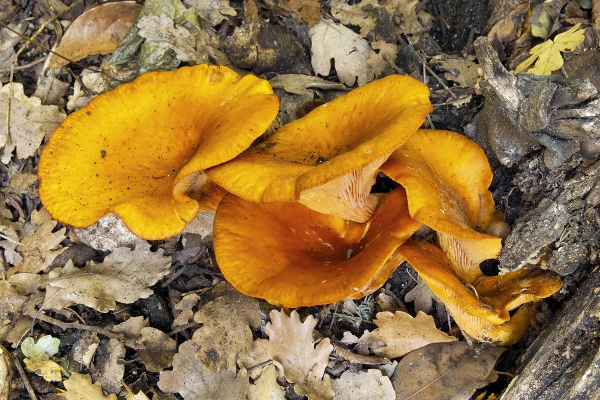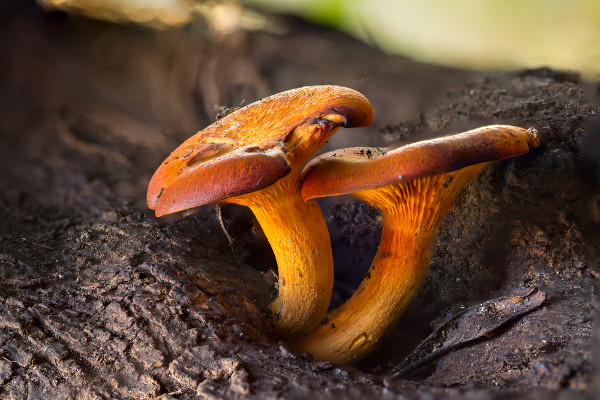Jack O’Lantern mushrooms, with their unique appearance and bioluminescence, captivate both novice foragers and experienced mycologists. Identifying these fungi involves more than just visual cues, requiring a keen eye for specific distinguishing features.
Exploring their habitat, anatomy, and glowing properties adds depth to the process of accurate identification. Distinguishing true Jack O’Lanterns from toxic lookalikes is a complex yet rewarding pursuit, unveiling a world of intricate details and subtle differences.
Characteristics of Jack O’Lantern Mushroom
Jack O’Lantern (Omphalotus olearius) mushrooms, belonging to the Omphalotus genus, are characterized by their vibrant orange color and distinctive gills. They have caps that can grow up to 10 centimeters in diameter and stems reaching heights of 15 centimeters.
The gills, attached to the stem, are forked or veined, giving them a unique appearance. These mushrooms exhibit bioluminescence, emitting a faint greenish glow in the dark when young and fresh.
Despite their fascinating glow, they are toxic and should not be consumed as they can cause severe gastrointestinal issues.

Habitat and Growing Conditions
Jack O’Lantern mushrooms thrive in wooded areas rich in organic matter, particularly under oak or beech trees.
They need high moisture levels, typically found in damp, humid environments, and prefer shaded areas for optimal growth and development.
Ideal Growing Locations
Jack O’Lantern mushrooms flourish in damp, shaded environments with rich organic soil under hardwood trees like oak, beech, and maple. They thrive in wooded areas with decaying wood such as fallen logs or stumps, high humidity, and consistent moisture.
Ideal locations have a slightly acidic to neutral pH range, providing a suitable environment for their growth and proliferation.
Required Moisture Levels
To thrive, Jack O’Lantern mushrooms need humidity levels between 75-85%. Proper drainage is essential to prevent waterlogging.
Regular misting and monitoring with a hygrometer are key. Adjust watering based on environmental conditions to maintain stable moisture levels.
Shade Preference for Growth
Jack O’Lantern mushrooms thrive in shaded, damp locations like wooded areas and forests. They require filtered light and high humidity levels for optimal growth, making areas with a canopy cover ideal for their development.
It is recommended to forage for these mushrooms in shaded areas with the right balance of light and humidity to increase the chances of a successful harvest.
Cap and Gills Appearance
The cap and gills of Jack O’Lantern mushrooms are important for identification. These mushrooms have:
- Orange to yellow caps
- Decurrent gills attached to the stem
- Bright orange gills
- A convex cap shape that may flatten with maturity
- Distinct spacing between the gills.
Stem and Ring Features
When identifying Jack O’Lantern mushrooms, it is vital to note the tall and slender stems, which range from 5 to 15 centimeters in height. These stems are typically pale orange with a fibrous texture and lack a distinct ring or veil. This absence of a ring helps differentiate Jack O’Lantern mushrooms from deadly Amanita species, which have a prominent ring on the stem. See the table below for a summary of key stem and ring features of Jack O’Lantern mushrooms:
| Feature | Description | Importance |
|---|---|---|
| Stem Height | 5-15 cm | Species determination |
| Stem Color | Pale orange | Differentiation |
| Ring Presence | Absent | Vital for identification |

Spore Print Color
When identifying Jack O’Lantern mushrooms, the spore print color is critical. Jack O’Lantern mushrooms typically have a bright yellow to orange spore print color, which distinguishes them from similar species.
To obtain a spore print, place the mushroom cap gills down on paper or glass overnight. Handling mushrooms carefully during this process is important to prevent contamination with other spores.
Bioluminescent Properties
Jack O’Lantern mushrooms stand out in the fungal world due to their bioluminescent properties, emitting a soft greenish glow in the dark. This glow, attributed to a chemical reaction involving luciferin and luciferase enzymes, attracts insects for spore dispersal.
Not all Jack O’Lantern species exhibit bioluminescence, so proper identification is essential. Despite their captivating glow, these mushrooms are toxic and should not be consumed.
Seasonal Occurrence
The Jack O’ Lantern mushroom’s bioluminescent glow is captivating; however, understanding its seasonal occurrence is crucial for accurate identification and safety. These mushrooms predominantly appear from late summer to early fall, thriving in warm and humid conditions. They are commonly found in deciduous forests across North America and Europe, particularly in areas rich in oaks and other hardwood species. Typically, they grow on decaying wood, often near tree stumps or roots.
Odor and Taste Profile
Jack O’Lantern mushrooms have a fruity or musty odor, which becomes stronger as they mature. Their taste is described as bitter or peppery, attributed to compounds like illudin. When cooked, their taste remains bitter.
These distinct characteristics aid in their identification and differentiate them from similar species.
Lookalike Warning Signs
Foraging for Jack O’Lantern mushrooms requires caution due to their resemblance to certain toxic species, which can pose serious health risks if mistaken. To ensure safe foraging, it is essential to distinguish key features between Jack O’Lantern mushrooms and their toxic lookalikes.
Here are the key differences to watch out for:
- Gills: Jack O’Lantern mushrooms have decurrent, bright orange gills, while toxic lookalikes have non-decurrent, pale gills.
- Cap Shape: Jack O’Lantern mushrooms have a convex shape with a wavy margin, whereas toxic lookalikes have flat or irregular caps.
- Bioluminescence: Jack O’Lantern mushrooms are bioluminescent, while toxic lookalikes are non-bioluminescent.
- Habitat: Jack O’Lantern mushrooms are found in woodlands near decaying wood, while toxic lookalikes can be found in various habitats.
Edible Look-Alikes
Distinguishing Jack O’ Lantern mushrooms from their edible counterparts is essential to avoid potential poisoning. Here are some common edible look-alikes and distinguishing features:
- Chanterelles: These mushrooms have a white or pale yellow spore print, unlike the Jack O’ Lantern’s characteristic orange spore print.
- False Chanterelles: Although similar in appearance, they lack the bioluminescent glow that is typical of Jack O’ Lantern mushrooms.
- Omphalotus illudens: While often confused due to their shape, these mushrooms emit a bioluminescent glow, a feature absent in chanterelles.
Ensuring accurate identification through spore prints and other distinct characteristics is imperative for safe foraging.
Safety Precautions
When foraging for mushrooms in the wild, it is paramount to adhere to safety protocols to avoid toxic exposures. Always wear gloves and carry a comprehensive guidebook to ensure precise identification of mushrooms. Jack O’ Lantern mushrooms can be easily mistaken for edible varieties, but their toxicity necessitates careful handling. Avoid direct contact with bare hands, as their toxins can cause skin irritation.
Upon discovering a mushroom, consult your guidebook immediately to prevent any hazardous mix-ups. It is also advisable to use a small container for collecting samples, thereby preventing accidental contact with other belongings. Given the striking similarity between some toxic and edible mushrooms, meticulous attention to detail is vital for safe foraging practices.



